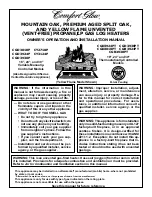
17
9.
Water Piping
This appliance suitable for potable water and space heating applications. Do not use this appliance if any part has
been underwater. Immediately call a qualified service technician to inspect the appliance and replace any part of the
control system and gas control which has been under water.
If the water heater is installed in a closed water supply system, such as one having a backflow preventer in the cold
water supply line, means shall be provided to control thermal expansion. Contact the water supplier or a local plumb-
ing inspector on how to control this situation.
A pressure relief valve must be installed near the hot water outlet that is rated in accordance with and complying with
either The Standard for Relief Valves and Automatic Shutoff Devices for Hot Water Supply Systems, ANSI Z21.22, or
The ANSI/ASME Boiler and Pressure Vessel Code, Section IV ( Heating Boilers ). This pressure relief valve must
be capable of an hourly Btu rated temperature steam discharge of 180,000 Btuh. Multiple valves may be used. The
pressure relief capacity must not exceed 150 psi. No valve shall be placed between the relief valve and the water
heater. The relief valve must be installed such that the discharge will be conducted to a suitable place for disposal
when relief occurs. No reducing coupling or other restriction may be installed in the discharge line. The discharge line
must be installed to allow complete drainage of both the valve and the line. If this unit is installed with a separate
storage vessel, the separate vessel must have its own temperature and pressure relief valve. This valve must also
comply with The Standard for Relief Valves and Automatic Gas Shutoff Devices for Hot Water Supply Systems, ANSI
Z21.22. (in the U.S. only). A temperature relief valve is not required, but if one is used, do not install the valve with the
probe directly in the flow of water. This may cause unwarranted discharge of the valve.
Piping and components connected to the water heater shall be suitable for use with potable water.
Toxic chemicals, such as those used for boiler treatment, shall not be introduced into the potable water.
A water heater used to supply potable water may not be connected to any heating system or components previously
used with a nonpotable water heating appliance.
When water is required in one part of the system at a higher temperature than in the rest of the system, means such
as a mixing valve shall be installed to temper the water to reduce the scald hazard.
• Flush water through the pipe to clean out metal powder, sand and dirt before connecting it.
• Take appropriate heat insulation measures (e.g., wrapping with heat insulation materials, using electric heaters)
according to the climate of the region to prevent the pipe from freezing.
• Use a union coupling or flexible pipe for connecting the pipes to reduce the force applied to the piping.
• Do not use piping with a diameter smaller than the coupling.
• When feed water pressure is too high, insert a depressurizing valve, or take water hammer prevention measure.
• Avoid using joints as much as possible to keep the piping simple.
• Avoid piping in which an air holdup can occur.
• If installing the unit on a roof:
• About lower-level hot water supply
If the unit is installed on a roof to supply water to the levels below, make sure that the water pressure supplied to
the unit does not drop below 29 psi. It may be necessary to install a pump system to ensure that the water pressure
is maintained at this level.
Check the pressure before putting the unit into operation.
Failure to supply the proper pressure to the unit may result in noisy operation, shorter lifetime of the unit, and may
cause the unit to shut down frequently.
Supply water piping
• Do not use PVC, iron, or any piping which has been
treated with chromates, boiler seal or other chemicals.
• Mount a check valve and a shut off valve (near the inlet).
• In order for the client to use the water heater
comfortably, 98.1 to 491 kPa (14 to 70 psi) of
pressure is needed from the water supply.
Be sure to check the water pressure. If the water
pressure is low, the water heater cannot perform
to its full capability, and may become a source of
trouble for the client.
Drain piping
• Expansion water may drop from the pressure
prevention device and wet the floor. If neces-
sary, provide drain piping or use a drain hose to
remove the water.
Hot water piping
• Do not use lead, PVC, iron or any piping which
has been treated with chromates, boiler seal or
other chemicals.
• The longer the piping, the greater the heat loss.
Try to make the piping as short as possible.
• Use mixing valves with low water resistance. Use
shower heads with low pressure loss.
• If necessary, use a pump or other means to en-
sure that the supply water pressure to the inlet of
the heater does not fall below 29 psi when the
maximum amount of water is being demanded.
Also install a pressure meter on the inlet. If this is
not done, local boiling will occur inside the water
heater causing abnormal sounds and decreasing
the durability of the heat exchanger.
Installation and service must be performed by a qualified plumber. In the
Commonwealth of Massachusetts, this product must be installed by a licensed
plumber or gas fitter in accordance with the Massachusetts Plumbing and Fuel
Gas Code 248 CMR Sections 2.00 and 5.00. Observe all applicable codes.
SAR8584C̲015̲025̲E̲J.p65
06.11.2, 11:06 PM
Page 17
Adobe PageMaker 6.5J/PPC











































